Sunday May 17 — Today was the big day. The wedding began at 1430. Eric wasn’t feeling good, so he spent the morning resting. The women spent the morning obsessing about minute little details. The men waited anxiously, looking at their watches every 5 minutes until it was finally time to get ready. Costas has had a beard for a while now and his male friends decided the beard needed to go and forcibly shaved it off.
We arrived at the church 20 minutes before the ceremony was supposed to start. The tradition is that everyone stands outside and waits for the bride to arrive. The groom meets her outside and they walk in together, then everyone follows them in. It was a small wedding with only 900 guests, and the courtyard outside the church was jam packed. Were we being facetious when we said “small wedding?” No. In villages, the whole village is invited, and weddings with as many as 5,000 guests are common. We went to a wedding with 3,000 people once a few years ago. It was crazy. In the cities, though, weddings tend to be much smaller. We noticed a few men were dressed in traditional Cretan costumes. Here are some of the more traditional dressers posing with Costas.
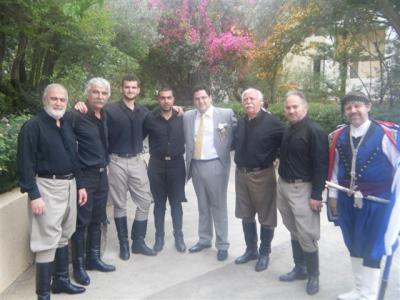
The church is at the top of a hill, with a long path that leads from the parking lot up the hill. Here is a shot of it from the parking lot.
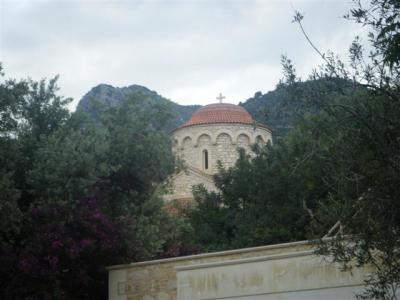
We knew the bride had arrived when we heard a symphony of car horns down below. A few minutes later, Koralia walked up in a stylish white gown, accompanied by her parents, sister (maid of honor), and five adorable little flower girls.
They were met at the edge of the church courtyard by Costas, Maria (Costas’ mother), John, and two groomsmen. Everyone in the group exchanged greetings, then Koralia and Costas joined hands and led the rest of the bridal party towards the church entrance.
A priest was standing outside the church doors, holding a framed picture of the Virgin Mary. Costas and Koralia stopped in front of the priest. The priest said some words in Greek that Eric and Christi couldn’t follow. Both Costas and Koralia kissed the picture, the purpose being to venerate Mary’s divinity. Then the priest stepped aside and the entire entourage went in.
Nine priests stood in front of the altar. The adults in the bridal party formed a horizontal line about 20 feet back from the altar, each person facing it. A small round table stood between the wedding party and the priests. The first picture is of the altar area before the wedding started, so you can get a sense of what it looked like. The second shot is of 7 of the 9 priests. Well, 5 whole priests and two half priests. There was no way we could get all 9 into one shot.
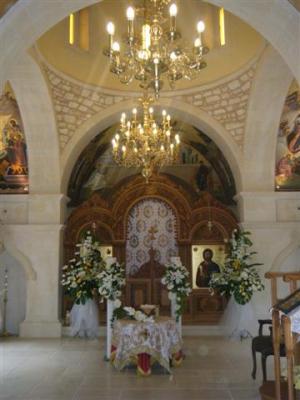
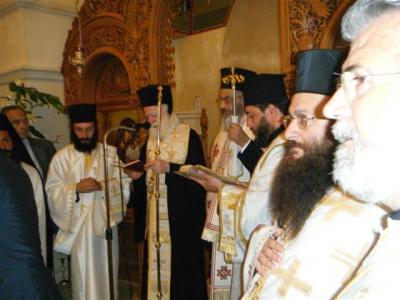
No, it is not normal for there to be nine priests. Usually, there is only one. Costas’ maternal grandfather used to be a teacher at the seminary, and several of his devoted students had wanted to be the one to officiate his grandson’s wedding. Apparently, instead of choosing one, they let them all do the ceremony together.
Now, you are probably assuming that with 900 attendees and 9 priests, this must be one huge church. It isn’t. In fact, it is tiny. There are no seats at all inside the church, and with everyone standing shoulder to shoulder, the maximum capacity of the building is probably around 75 people. Once the wedding party had entered, the spectators started shoving their way in behind them. Eric, Christi and Andronikos shoe-horned our way to the family section, just to the right of where the wedding party stood. The rest of the bride’s family stood to the left of the wedding party. Needless to say, we were packed in like sardines.
One of the priests approached Costas and Koralia. He picked up a book with a silver cover off the table. This was a liturgical book of sermons. He read a short passage aloud, then pulled out a ring and waved it around as he spoke. We are guessing at this point he was saying prayers over the ring. He spoke some, read some, and waved the ring around some. He put the ring on Koralia’s finger, then repeated the process with Costas’ ring. While this was going on, the flower girls quietly pushed through the crowd handing out packets of rice.
When the priest was done with the rings, the bride, groom, groomsmen and flowers girls walked forward to the altar. The maid of honor and all four parents stayed behind. There were two small crowns on the table. A priest picked up the crowns, placed them on Costas and Koralia’s heads, then took them back off, then repeated two more times. He was speaking the entire time, and we assume they were more prayers. Then the two groomsmen did the same thing with the crowns putting them on and then taking them off Costas’ and Koralia’s heads three times. The priest had put the same crown on their respective heads each time, but the groomsmen had deliberately rotated the crowns back and forth between Costas and Koralia.
Still wearing the crowns, the bride and groom, along with the groomsmen and flower girls, circled the small table three times, which is actually supposed to be a dance of sorts. Everyone in the crowd threw rice at the wedding party as they made their circles.
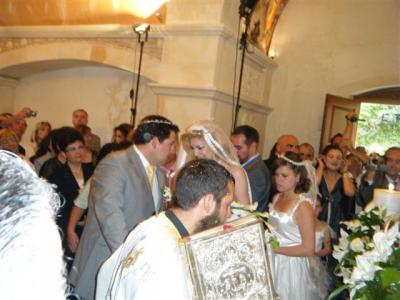
Then the party went back to the altar, where the priest took off the crowns. The ceremony was now over. Normally, there is a sermon in the ceremony somewhere, but Costas and Koralia had decided against a sermon. We found it funny that they had so many priests, yet no sermon.
Costas, Koralia, their parents and the flower girls went out the side door and lined up, preparing to greet their guests. Someone placed a red ribbon around both Costa’s and Koralia’s necks, which is a Cretan specific tradition. Every single guest walked through the church and out the side door to congratulate the bride, groom and their parents. The flower girls dutifully made sure each and every person got a favor. The line was extensive and slow moving, and it took them a long, long time to greet all 900 people.
After everyone was greeted, we took professional photos, then headed to the reception. Inside, the hall was enormous and virtually every seat was filled. The seats were crammed in close together, too. As is typical of Greeks, they started feeding you literally the minute you walked in the door. There was a canapés and champagne station at the entrance and an assortment of appetizers already on the tables, including salad, cheese slices, beets, bread, lamb, liver, meatballs, octopus, and zucchini and eggplant stuffed with ground beef and topped with mashed potatoes.
Costas and Koralia made a formal entrance, with the DJ announcing their arrival. Pretty much as soon as they walked in, they sat down and the formal meal began. There was not a prayer before the meal, which shocked Andronikos. The main course was another type of lamb dish served with rice, and the portions were huge. For dessert, everyone was served fruit slices and small pastries. Oddly, well after dessert had been cleared, another small plate of food was served pasta with cheese. We can’t emphasize enough how much food there was and how stuffed we were!
Almost as soon as the bride and groom sat down to eat, a professional dance troupe came out wearing traditional costumes and performed several traditional Greek dances. The dancers were accompanied by a Greek band using traditional instruments. Greek music is similar to traditional Eastern style music heard in places like Turkey, Egypt and Oman.
When the troupe was done, Koralia and Costas were called out to the dance floor to lead a dance for their guests. Dozens of people poured out on stage to join the dance. Everyone danced in a ring, but Koralia was the head of the ring. People took turns dancing next to her. From then on out, the dancing was non-stop. For every single song the dance floor was packed with people, and not the same people, either. It seemed like every guest took their turn on the dance floor. Since dinner was going on, the people would eat a little, dance a little, eat some more, then dance some more.
All the dances were similar in that everyone would do the same steps while moving in a ring. People would sometime take turns “solo-ing”, meaning they would go out to the center of the circle and do some flashy moves. When someone went into the middle, everyone else would stop and watch, then the circle would resume motion as soon as the person in the center rejoined the group. The dance floor wasn’t dominated by women, as it often is in the US. There were as many, sometimes more, men out on the dance floor, and the men tended to be more exuberant in their dancing style. The men seemed to do more solos — often jumping in the air and hitting one of their feet with their hands while in mid-air, and some even went so far as to simultaneously spin while jumping and hitting their feet. The traditional dancing lasted for five solid hours, and was lively and fun the entire time. Then the music switched gears to popular rock, and the dancing continued on for another two hours.
Seeing this reception made us stop and think about American wedding receptions. Americans have a lot of rituals. Here there were no speeches, no toasts, no first dance as a couple, no father/daughter/mother/son dance, no cake, no cake cutting, no cake feeding, no garter toss, no bouquet toss. We wonder how we wound up with so many customs and where they all came from.
Christi has been diligently working on her Greek. She had learned how to say “beautiful wedding” this morning. As we were finally leaving the reception in the wee hours of the morning, Christi went up to Koralia’s mother and said what she thought was “beautiful wedding”. Argiri turned white and looked horrified. Later, Christi found out that she has mispronounced one of the words and had actually said “great sex”. Seriously offending your new in-laws always gets relationships off on the right foot. Fortunately, Costas thought it was hilarious and said she knew I had made a mistake.
